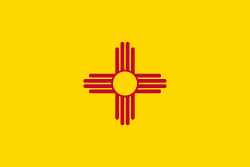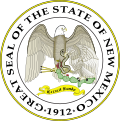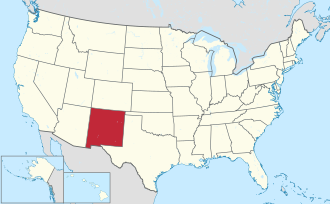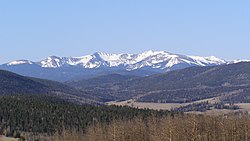New Mexico
New Mexico (Spanish: Nuevo México[Note 2][6] [ˈnweβo ˈmexiko] (![]() listen); Navajo: Yootó Hahoodzo Navajo pronunciation: [jòːtʰó hɑ̀hòːtsò]) is a state in the Southwestern region of the United States. It also borders Texas to the east and southeast, Oklahoma to the northeast, and the Mexican states of Chihuahua and Sonora to the south.
listen); Navajo: Yootó Hahoodzo Navajo pronunciation: [jòːtʰó hɑ̀hòːtsò]) is a state in the Southwestern region of the United States. It also borders Texas to the east and southeast, Oklahoma to the northeast, and the Mexican states of Chihuahua and Sonora to the south.
New Mexico became a state on January 6, 1912, and became the 47th state accepted into the United States. The state capital is Santa Fe. Most of the people live in the biggest city, Albuquerque.
Climate
The climate for most of the state is generally semi-arid. In the summer it can be very hot in southern New Mexico. The temperature is sometimes over 100 °F (37.8 °C) with lows over 70 °F (21.1 °C). It occasionally snows in the northern part of the state in the winter. It is drier in the southern portion of the state, and it rarely snows. New Mexico is usually affected by the North American monsoon from mid-June to late September.
History
New Mexico is the long-time home of the Pueblo people, a group of Native Americans. The area was named Nuevo México (New Mexico) by the Spanish in the mid-1500s and officially settled in 1598, its capital, Santa Fe, was selected in 1610. In the late 1600s, the Pueblo people revolted against the Spanish. The Spanish returned twelve years later and made a better attempt at giving the Pueblos better representation in New Mexico’s society and government. One such Spanish governor of New Mexico, who is most well-known for his work with Native Americans, was Tomás Vélez Cachupín.
When Mexico became independent in the early 1800s, New Mexico was part of it. Mexican rule was unpopular in New Mexico, which led to another revolt called the Chimayo Rebellion.
In 1846, the United States and Mexico went to war over a border dispute in Texas (a former state of Mexico that was its own country for a time and then joined the United States), and the Americans won the war. The peace treaty the two countries signed gave what is now called the American Southwest to the United States. While most of what was then Northern Mexico did not have a large amount of people living in it, New Mexico had population centers in Pueblo and Spanish towns, especially along the Rio Grande River and in the Sangre de Cristo mountains. The New Mexican citizens living there were allowed to stay if they agreed to become US citizens, and over 90% did so.
After some time as a territory, the area became a state in 1912.
New Mexico Media
- Flickr - USCapitol - Po’pay Statue.jpg
Statue of Popé, leader of the Pueblo Revolt of 1680. The statue, entitled Po'pay, is among two statues depicting New Mexicans at the United States Capitol National Statuary Hall Collection, the other being Dennis Chávez.
A homesteader and his children at the New Mexico Fair in Pie Town, New Mexico, 1940
Related pages
Notes
- ↑ 1.0 1.1 Elevation adjusted to North American Vertical Datum of 1988.
- ↑ In Peninsular Spanish, a spelling variant, Méjico, is also used alongside México. According to the Diccionario panhispánico de dudas by Royal Spanish Academy and Association of Academies of the Spanish Language, the spelling version with J is correct; however, the spelling with X is recommended, as it is the one that is used in Mexican Spanish.
References
- ↑ 1.0 1.1 1.2 "United States Summary: 2010 – Population and Housing Unit Counts" (PDF). U.S. Census Bureau. September 2012. p. 41. Retrieved March 14, 2020.
- ↑ "Wheeler". NGS data sheet. U.S. National Geodetic Survey. http://www.ngs.noaa.gov/cgi-bin/ds_mark.prl?PidBox=GM0779.
- ↑ 3.0 3.1 "Elevations and Distances in the United States". United States Geological Survey. 2001. Archived from the original on October 15, 2011. Retrieved October 24, 2011.
- ↑ Neomexicano definition Archived June 27, 2018, at the Wayback Machine by Royal Spanish Academy (Real Academia Española)
- ↑ "Most spoken languages in New Mexico in 2010". MLA Data Center. Archived from the original on May 23, 2013. Retrieved November 4, 2012.
- ↑ "México" in Diccionario panhispánico de dudas by Royal Spanish Academy and Association of Academies of the Spanish Language, Madrid: Santillana. 2005. ISBN 978-8429406238.
Other websites
| Wikimedia Commons has media related to Lua error in Module:Commons_link at line 62: attempt to index field 'wikibase' (a nil value).. |
- New Mexico Indian Tribes Archived 2007-06-04 at the Wayback Machine
- New Mexico Monuments
- New Mexico National Parks
- Gila National Forest Archived 2007-07-26 at the Wayback Machine











